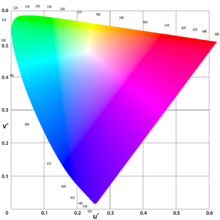CIELUV color space system
The CIE- LUV color space system , also L * u * v * color space , developed in 1976 , is calculated from the CIE (XYZ) system in a similar way to the CIE Lab color space system in order to better assess differences between any colors. It is therefore preferred for the measurement of light colors , e.g. B. for the evaluation of light sources , monitors and projectors .
The comparability of colors in the CIE-LUV color space requires a representation of the color space that is as equally spaced as possible , i.e. H. Hues of the same geometrical distance should be approximately the same sensation have proper distance.
description
The equidistant representation can be obtained from the combination of the perceptual color table CIE-UCS ( Uniform Color Scale ) with the equidistant brightness scale .
Chromaticity plane
The axes of the chromaticity plane of the L * u * v * color space intersect at the achromatic point of the UCS color table. The u * axis is in the direction of red-green, positive values of u * point to red and negative values to green; accordingly, the v * axis lies in the direction of blue-yellow, positive values of v * point to yellow and negative values to blue:
With
- the value L * on the brightness axis (see below).
- the (calculated) coordinates u n 'and v n ' for the reference white , the standardized color type at the white point :
- the tristimulus - color values X , Y , Z
- the normalized values u 'and v'; these can be transformed from the CIE color values X, Y, Z in such a way that the numerical values correspond better to the color perception:
- the coordinates x , y from the flat color table.
A representation in a right-angled coordinate system is possible, since u * and v * become zero when u 'and v' are zero.
Information is necessarily lost in the two-dimensional representation.
Brightness axis
The lightness axis is perpendicular to the chrominance plane in the white point and thus forms the achromatic axis.
The CIE has defined a brightness scale based on the Munsell system . Munsell brightness is recognized as a standard of brightness. However, further developments have taken place to reduce remaining inequalities.
L * is the psychometric brightness function, which is described by the equally spaced brightness scale. The adaptation of the human eye to differences in brightness is largely logarithmic : the same difference in luminance ΔY appears as a large difference in brightness at lower luminance and as a small difference in brightness at high luminance.
The value range of the brightness is in the interval = 0 for black to = 100 for white .
In addition, the following polar parameters, which are closer to the description of human perception, can be derived; the terms chroma and saturation are sometimes used differently in the specialist literature.
Colourfulness
The colorfulness (chroma)
indicates the distance between the color and the achromatic point. With constant chroma, the color point moves on a straight line parallel to the achromatic straight line L *, and the hue changes.
saturation
The saturation represents the distance of the respective color point from the achromatic point in the color table. With constant saturation there is a straight line through the zero point.
Hue angle
The hue angles (hue) are interpreted as angles in the four quadrants .
Shade difference
The shade difference is
- positive if the hue angle h uv increases,
- negative if the hue angle h uv decreases.
rating
The color difference : indicates how strongly two colors differ from one another according to their perception.
It usually denotes a just noticable difference (abbreviated JND).
It should be noted that the CIE-LUV system is only approximately equally spaced. This is shown by a comparison with the Munsell color system . The CIE-LUV system represents color coordinates and not a color type, since the additive mixture of two colors does not lie on a straight line. To represent additive mixtures, a color table assigned to the CIE-LUV color space was developed (u'v 'diagram), similar to the standard color table (xy diagram). This color table shows color distances more faithfully than the xy diagram. When specifying the sizes of the CIE-LUV color space, the addition “CIE-LUV 1976” is always required to clearly identify which sizes are involved. More equally spaced systems are, for example, the color spaces DIN99 , CIELAB and CMC (l: c).
literature
- Bergmann, Schaefer: Textbook of Experimental Physics, Volume 3, Optics . Walter deGruyter, Berlin 2004.
- E. Dörsam: Color rendering in the media . Lecture Ws 08-09, TU Darmstadt
- R. Greule: Script for the lecture colorimetry . HAW-Hamburg
Web links
- Bruce Lindbloom with color diagrams and coordinate conversion aids
















